Chronicles of Rolex Bezels
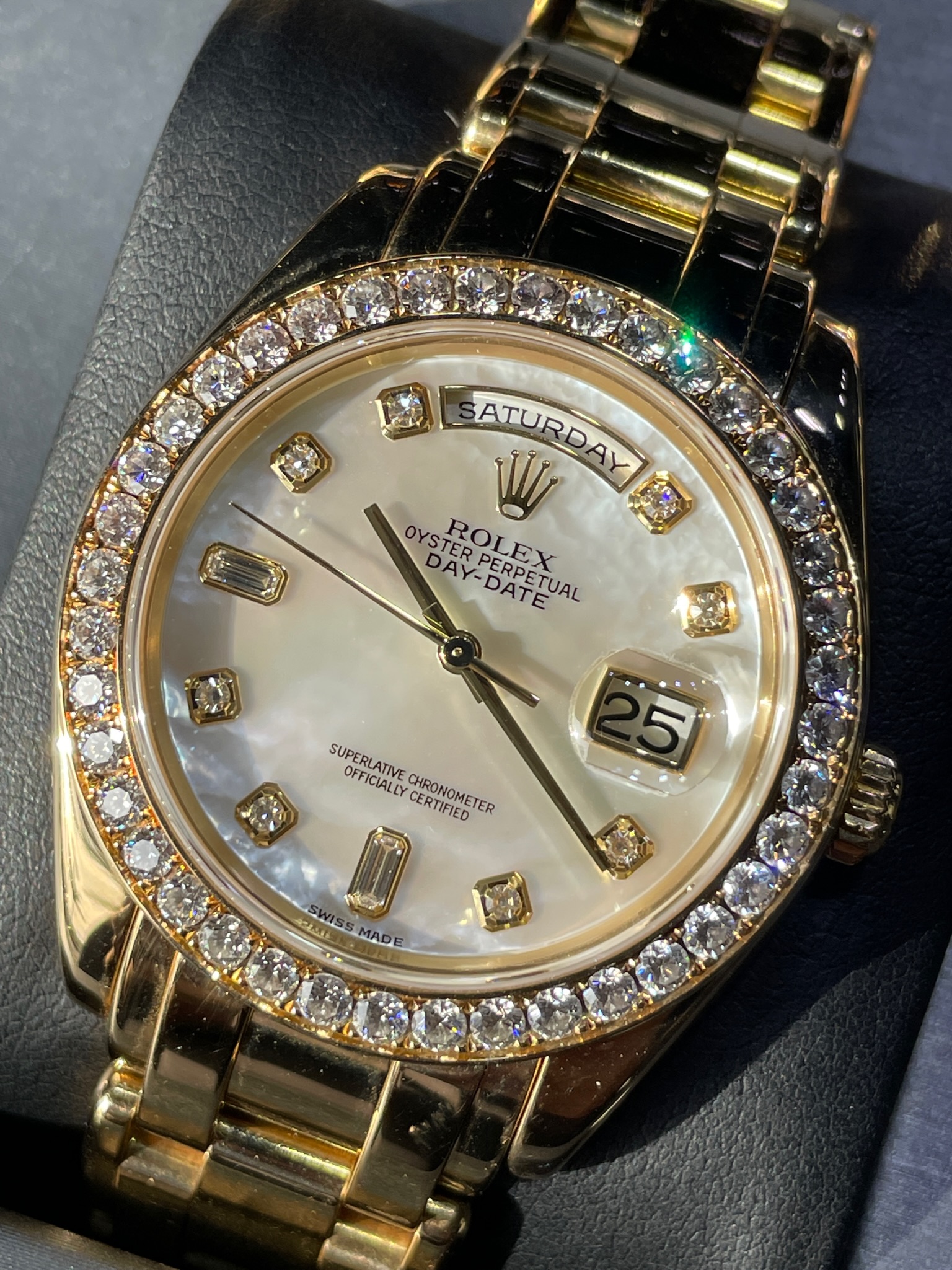
When you consider the different important parts of a Rolex watch, it is not an in-depth look if the physical components don’t include Rolex bezels. This part is one of the vital elements that make up a Rolex wristwatch. In this text, we will consider the Rolex bezels, there is a wide array to look into. Also, depending on the Rolex model, the bezel can either be a decorative part or a functional part of the Rolex wristwatch.
The bezel is the metallic or ceramic ring that covers up the face of any timepiece on the outside of its case. Because of its relative size and notable position, the bezel has a considerable impact on the general aesthetic and functionality of a wristwatch. Here is a rundown of the various types of bezels that have outfitted Rolex’s various watches since inception
Rolex Bezels: The Decorative and The Functional
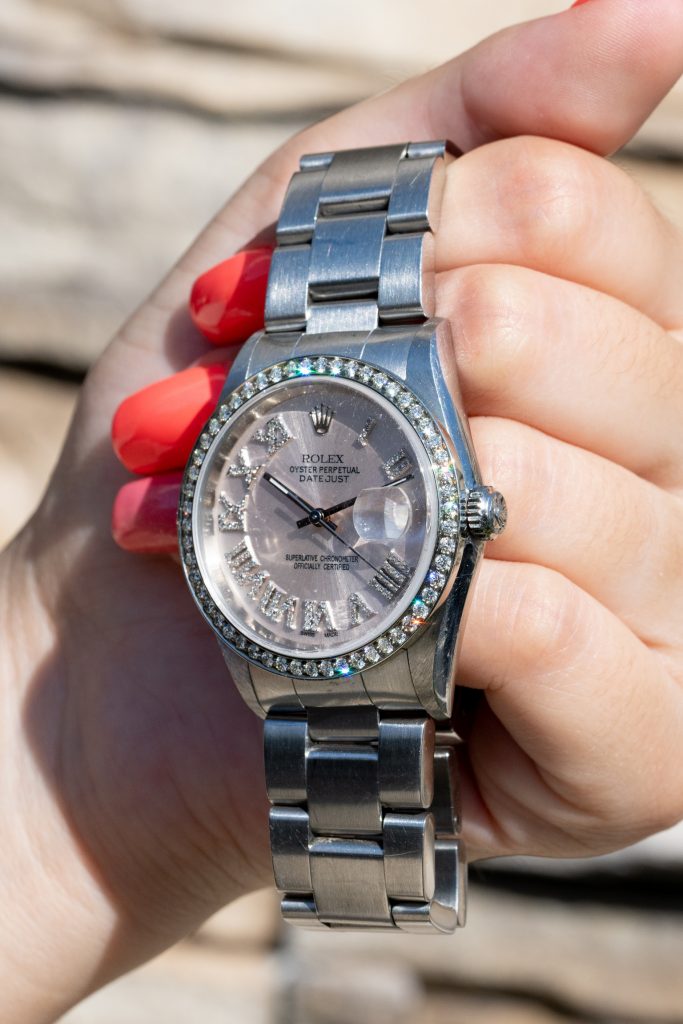
We must state first that the first purpose of a Rolex bezel is to ensure the crystal stays down to the case. That way, the bezel ensures there’s a watertight seal. Still, besides that, the design of a bezel can be solely either decorative or functional.
The Decorative Rolex Bezels
- Fluted Bezel
The fluted bezel is possibly the most popular type of Rolex bezel. Quickly noticeable, the fluted bezel brings in an aura of formality to a Rolex thanks to its aesthetics and material components. A fluted Rolex bezel is solely a product of gold. The fluted bezels are very common parts on Air-King watches, Datejust timepieces, Day-Date watches, and Oyster Perpetual watches.
- Domed Bezel
Being the most basic Rolex bezels out there, the domed bezel (also known as the smooth bezel) is not one with adornments. This bezel only features a flat and clean surface. Plus, its design is minimalistic. It is the most adaptable of Rolex bezels as it comes in steel, all three shades of gold, and platinum.
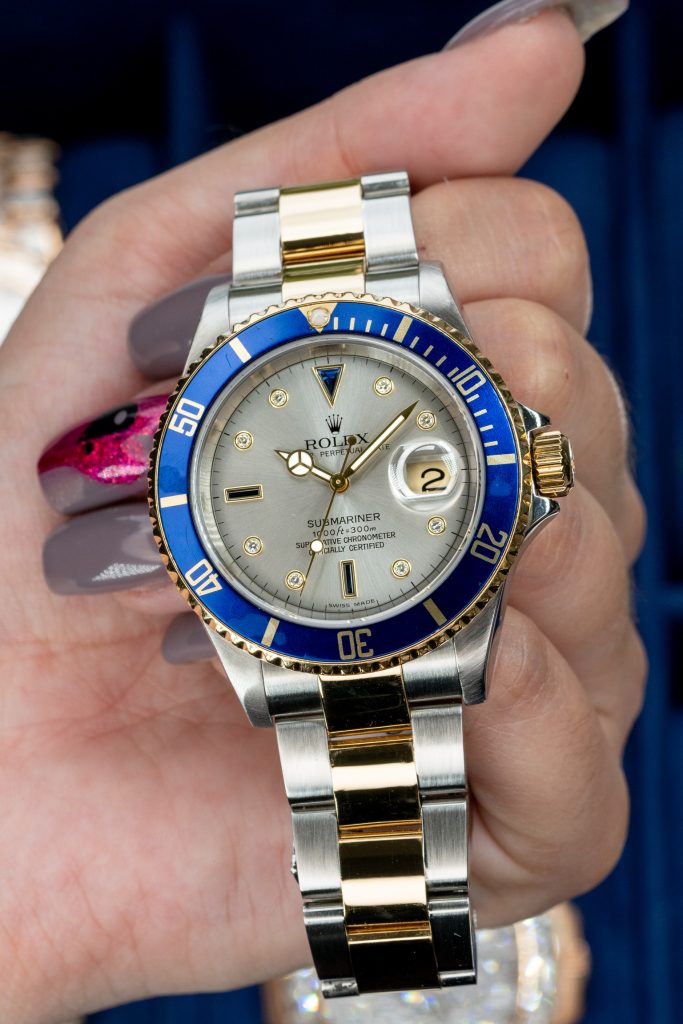
More so, you can find these bezels across most Rolex lineups. It is a regular figure on Air-King watches, Datejust watches, Date watches, Day-Date watches, Explorer watches, Oyster Perpetual watches, and Milgauss watches.
- Gem-Set Rolex Bezel
Together with master watchmakers, Rolex also parades a team of master jewelers. These jewelers are in charge of setting diamonds and other precious gems (sapphires, emeralds, and rubies) into the company’s time tools.
The brand offers a vast array of gem-set bezels, which can house round-cut diamonds, baguette-cut diamonds, multicolored baguette-cut sapphires, etc. These gem-set bezels are most often a part of Rolex’s dressier timepieces. You will find them on Pearlmaster watches, Day-Date watches, and Datejust watches.
Nonetheless, this watchmaker has also had a history of creating gem-set bezels for special editions of their famous sports wristwatches as well. Examples include the GMT-Master II, the Yacht-Master, the Daytona, and even the Submariner.
Rolex Bezels: Decorative But Discontinued
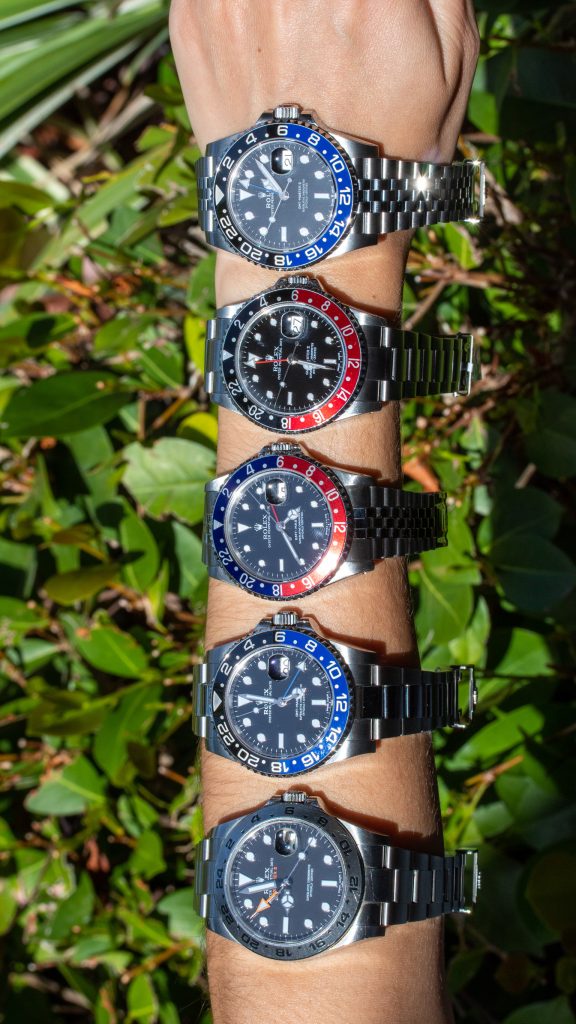
The Discontinued Engine-Turned Bezels
Truly, Rolex no longer produces an engine-turned bezel. Yet, these bezels are available on vintage steel models. Defined by their steel construction and textured finish, an engine-turned Rolex bezel used to feature on Rolex watches like the Date watches, Datejust watches, Air-King watches, and Oyster Perpetual timepieces.
The Discontinued Bark Bezel
Also, Rolex no longer manufactures the bark bezel. First, its name is due to its texture that looks like the surface of tree bark. These bezels were Jn production for decades. Entirely made in either yellow or white gold, the bark bezel is a part of vintage Day-Date watches (in rarer cases, on vintage Datejust watches too). Most times, they come together with a bracelet featuring center links also adorned with the bark finish.
The Discontinued Florentine Bezel
Commonly found on old-fashioned jewelry, the Florentine finished bezel has a unique feature in its series of notches overlaying a metal covering. Also, the Florentine style bezel is rare to find presently. Back then, Rolex did use this outstanding decorative notch on some vintage Datejust and Oyster Perpetual wristwatches.
The Discontinued Greek Key Bezel
You can find this super rare Greek Key Bezel featured on the vintage Oyster Perpetual 1506. With this bezel, you find the well-known form of interlocking right-angled spirals known as the meander border or the Greek key.
The Discontinued Moiré Bezel
Made with inspos from the wavy watered look of moiré silk, the moiré finish is a product of interlaying two sets of parallel lines on top of each other. However, one of such lines comes slightly atilt to form a repetitious structure. In addition to Moiré bezels, Rolex also used the texture on some cases and bracelets featured on vintage Rolex watches.
The Discontinued Morellis Bezel
Back in the 1960s and 1970s, Rolex utilized the textured Morellis finish on some models. This bezel type has a major defining feature which is a crosshatch-like pattern. You can find Morellis bezels just like you can find matching Morellis bracelets and cases.
The Discontinued Moreau Bezel
This is another decorative and textured metal finish that you might not find again today. This discontinued Moreau bezel is featured on vintage Rolex watches in yellow gold. The defining feature is a reptile-like surface that comes notched around the bezel.
The Discontinued Pyramid Bezel
From its name, the Rolex Pyramid bezel comes with three-dimensional pyramid-shaped details. When you check out some Rolex Pyramid bezels, you discover they are better decorated with diamonds as well.
You can find these decorative bezels on vintage Lady-Datejust watches, vintage Day-Date watches, and vintage Oysterquartz Day-Date timepieces. The Oysterquartz with the Pyramid Bezel also features pyramid details on the center bracelet links and the watch also carries the name “Egyptian” Rolex.
The Discontinued Zephr Bezel
The Rolex Oyster Perpetual “Zephr” is unique and limited in supply vintage model. This bezel is a product of the 1950s down to the 1970s. Together with its trademark cross-hair dial, another emblem of the Zephr is its machined bezel. We sometimes refer to this as the Astral bezel. You also find, depending on the model, either faceted or engraved hour markers.
Functional Rolex Bezels
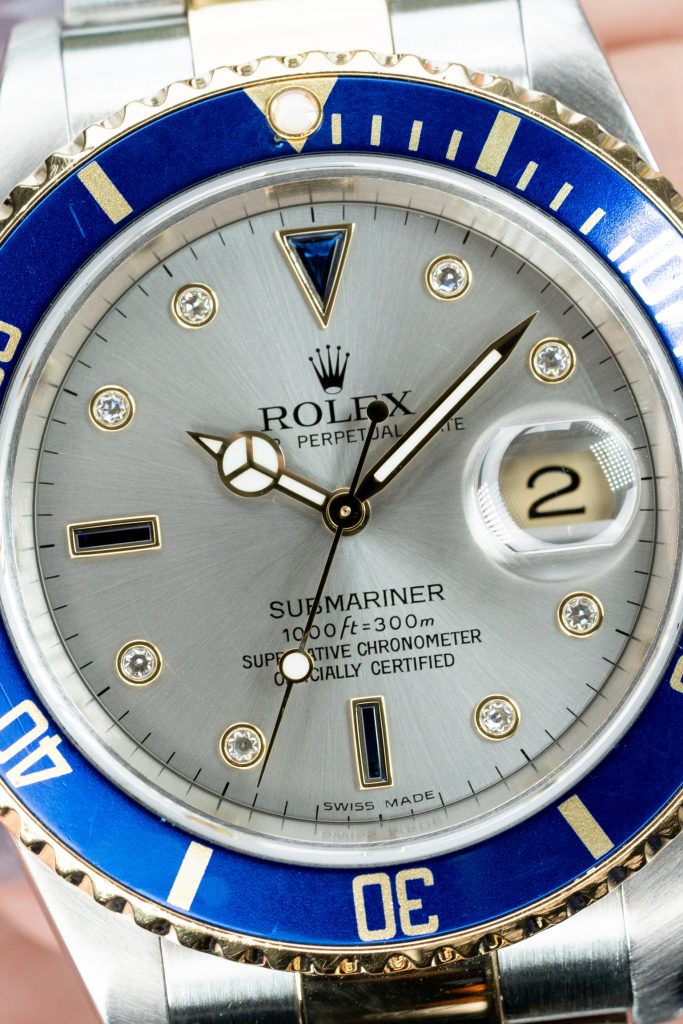
Dive Bezel
With dive watches, the bezel is an essential element for the watch’s functionality. The bezel is how divers keep track of how long they stay underwater. For dive bezels, typically come with 60-minute graduations and luminescence for better legibility underwater. Generally, Rolex’s dive watches—the Submariner, the Sea-Dweller, and the Deepsea— all come equipped with dive bezels. Commonly, they also had a few changes made to them in the last few years.
The coming of the first Submariner in the 1950s saw a Rolex timepiece fitted with a bidirectional black aluminum bezel. Nevertheless, this watchmaker soon displaced the bidirectional design and replaced it with a unidirectional rotating bezel.
With that change, Rolex delivered a failsafe to impede the diver from miscalculating immersion times. T comes in handy especially when the diver’s watch gets knocked. Likewise, aluminum was the chosen Rolex bezel material for most of the Submariner’s life. It is also available in black, blue, and green.
Still, Rolex presently uses scratch and fade-resistant Cerachrom ceramic for all their dive time tools. The ceramic bezels on the Sea-Dweller and the Deepsea are solely in black. As for the Submariner, you have a choice of either black, blue, or green.
GMT Bezel
The Rolex brand inscribed the GMT bezels with 24 hours to use in conjunction with a 24-hour hand on the dial. This made room for the wearer to read a second time zone. Some Rolex watches featured this 24-hour bezel. They include the GMT-Master, the GMT-Master II, and the Explorer II watches.
As soon as the GMT-Master timepiece made its debut in the 1950s, Rolex produced its bezel in Bakelite. This bezel came with luminescent numbers and spotlighted a red and blue colorway. For the second time zone function to be present, turn the bidirectional bezel so that the hour in the second time zone would match with the arrow-tipped 24-hour hand on the dial.
When you do this, the person wearing the wristwatch could quickly see local time via the center hour hand. Also, the second time zone becomes readable through the 24-hour hand. That’s not all, the use of the two colors on one bezel was to distinguish between daylight hours (red) and nighttime hours (blue) as displayed in the second time zone.
Moving From Bakelite to Aluminum
Bakelite as a material fell on to be too fragile side to function as a bezel material. Due to this, Rolex soon replaced it with aluminum. When you take away the actual red and blue, Rolex also delivered various GMT-Master aluminum bezel colors over the years.
The array of bezel colors featured includes black and red, brown and beige, monochromatic black, and monochromatic blue which you will seldom find. Eventually, in 2005, the first GMT-Master II timepiece featured a Cerachrom ceramic bezel.
In the years that followed, Rolex rolled out that material across all GMT-Master II timepieces. Presently, the Cerachrom ceramic bezel is available in black, black and blue, red and blue, and black and brown.
As for the Explorer II, it also has a bezel marked with 24 hours. Yet, it comes with a more basic design. This Explorer II model comes with a fixed steel bezel engraved with the numerals. So, to read the second time zone set the 24-hour hand on the dial. That allows it to point to a numeral on the bezel.
We must also point out that the 24-hour hand on the inaugural Explorer II (ref. 1655) was not detached from the main hour hand. Hence, the bezel of the first Explorer II was an AM/PM pointer and not a GMT type.
Rotating Timing Bezel
Many Rolex wristwatches, such as the Turn-O-Graph and the Yacht-Master come with a bidirectional rotating bezel marked to 60-minutes. This helps it to calculate elapsed times. To do this, turn the bezel so that the inverted triangle aligns with the minute hand on the dial. As soon as the timed event is over, the number the minute hand is pointing to (e.g. 20, 30, 40, and so on) on the bezel is the number of minutes that have elapsed.
In the beginning, the Turn-O-Graph was the first serially-produced Rolex timepiece that featured a rotating bezel. Introduced in early 1953, the Turn-O-Graph came out before the Submariner. Again, it displayed a bezel that appears just like the early Submariner models. Nevertheless, the Turn-O-Graph bezel developed over the years to become a metal kind. You either find it in steel or gold depending on the model of Rolex watch you go for. Later on, Rolex no longer produces the Turn-O-Graph wristwatch.
Additionally, the design of the Yacht-Master is exclusive to that collection in that it features polished raised numerals (rather than engraved ones) on a sandblasted setting. The model decides how you get it. For the Yacht-Master bezel, it comes in platinum, yellow gold, rose gold, and Cerachrom ceramic.
Tachymeter Bezel
Being a chronograph timepiece, the Rolex Daytona features a bezel with a tachymeter scale. With a tachometer, you can calculate the average speed (for example, of a moving car) per hour. You can do this over a certain distance; for instance, one mile.
To use it, just press the top pusher to trigger the center chronograph hand. As soon as you drive the car a mile, you press the same pusher to halt the chronograph hand. The area the chronograph hand points to on the tachymeter scale is what tells you the actual speed. A good example is the chronograph hand pointing to 110 on the bezel. That means the car was traveling at 110 miles per hour.
Throughout Daytona’s history, the Daytona always featured metal bezels like steel and gold, aluminum bezels, and gem-set bezels. Nevertheless, since 2011, they’re available with Cerachrom ceramic bezels also
Ring Command Bezel
This bezel works with the mechanical movement found in the watch. On the Rolex lineup, you can currently find two Ring Command bezels. You will find one on the Yacht-Master II and one on the Sky-Dweller watch.
As for the Yacht-Master II, you must turn the Ring Command bezel to set and synchronize the countdown timer. While for the Sky-Dweller, turning the Ring Command bezel gives room for the wearer to determine the function to adjust. It can either be the date, local time, or second-time zone function.
